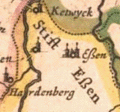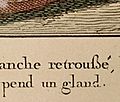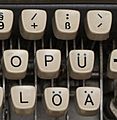SS facts for kids
The letter ß (also called sharp S or Eszett in German) is a special letter in the German alphabet. It's the only German letter that isn't part of the basic Latin alphabet we use for English. You pronounce the ß like the "s" in "see." This unique letter is only used in German words.
Contents
Where Did the ß Come From?
The letter ß we see today was created around the 1900s. It developed from two older letters: the long s (ſ) and the letter 'z'. Over time, when people wrote these two letters by hand, they often joined them together. This joining eventually formed the single letter ß that we know now.
How to Use the ß in German Words
The ß is only found in the German language. You will always see it in the middle or at the end of a German word. There is also an uppercase version of the letter, called ẞ. This capital letter is mainly used for things like dictionary entries or when you need to write a word entirely in capital letters.
Instead of using the lowercase ß, you can often write ss instead. For example, the word Straße (street) can sometimes be written as Strasse. However, not every ss can be changed to a ß.
When to Use ß or ss
The rules for German spelling changed in 1996. This change made it clearer when to use ß and when to use ss. Many common words that used to have ß are now spelled with ss.
Here's the main rule:
- Use ss when the vowel before it is short. For example, Fluss (river) has a short 'u' sound.
- Use ß when the vowel before it is long. For example, Straße (street) has a long 'a' sound.
ß in Compound Words
German often combines two or more words to create a new, longer word. If two 's' letters come together when words are joined, they usually stay as ss and do not become ß.
For example, if you combine "Voß" (a name) and "Straße" (street), you get "Voßstraße." This can also be written as "Vossstraße." However, you would never write "Vosßtraße." This is because the ß belongs to the first part of the word ("Voß"), and "sstraße" is not a separate word.
Images for kids
-
Replacement street sign in Aachen, adapted to the 1996 spelling reform (old: Kongreßstraße, new: Kongressstraße)
-
Capitalization as SZ on a Bundeswehr crate (ABSCHUSZGERAET for Abschußgerät 'launcher')
-
Use of ß in Polish language, in 1599 Jakub Wujek Bible, in the word náßéy, which means our, and would be spelled naszej in modern orthography.
-
Use of Middle High German letter “z” for modern “ß” in the beginning of the Nibelungenlied: "grozer" = "großer".
-
An early modern printed rhyme by Hans Sachs showing several instances of ß as a clear ligature of ⟨ſz⟩: "groß", "stoß", "Laß", "baß" (= modern "besser"), and "Faß".
-
SS from Hieronymi Aleandri Mottensis Tabulae utilißimae, Köln 1541.png
The ſs ligature used for Latin in 16th-century printing (utiliſsimæ)
-
Essen with ſs-ligature reads Eßen (Latin Blaeu atlas, text printed in Antiqua, 1650s)
-
SS handwritten sample.gif
Three contemporary handwritten forms of 'ß' demonstrated in the word aß, "(I/he/she/it) ate"
-
The ß key (as well as Ä, Ö, and Ü) on a 1964 German typewriter
-
Antiqua form of the ſʒ ligature (Berlin street signs)
-
Blackletter form of the ſʒ ligature (Erfurt street signs)
-
Sulzbacher form (Nürnberg street signs)
-
Two distinct blackletter typefaces in Mainz. The red sign spells Straße with ſs; the blue sign uses the standard blackletter ſʒ ligature.
See also
 In Spanish: ß para niños
In Spanish: ß para niños














